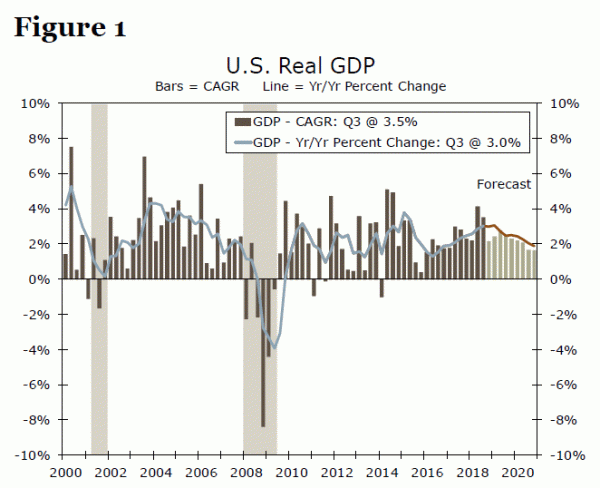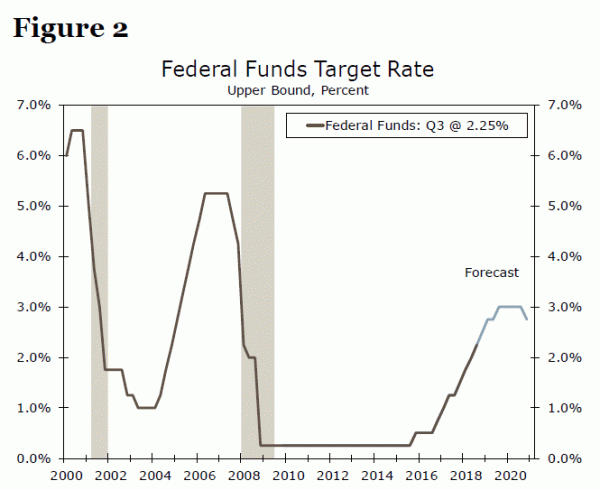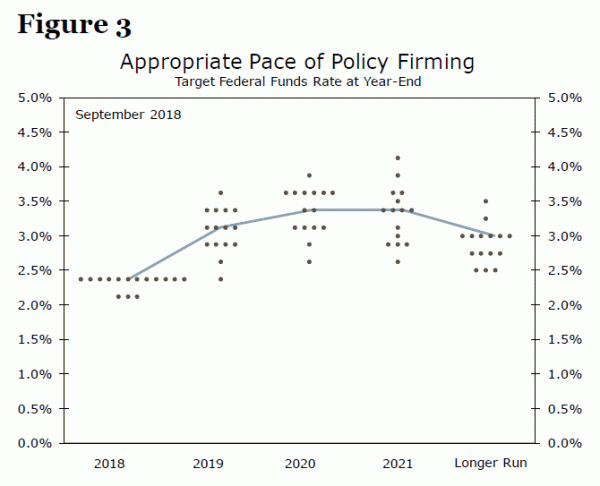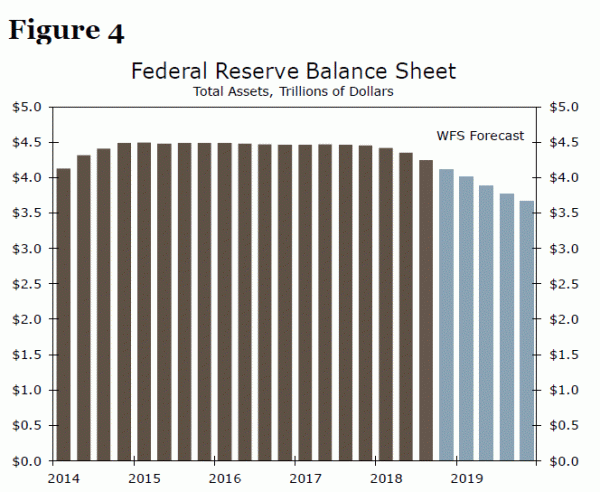On Wednesday, the Federal Open Market Committee (FOMC) will meet for the final time in 2018, and there is a higher-than-usual degree of uncertainty headed into the meeting as a result of financial market developments, macroeconomic concerns and some mixed messages from the Fed. So what do we expect to occur at the upcoming meeting? First, we expect a 25 basis point increase in the fed funds target range, bringing it up to 2.25%-2.50%, coupled with just a 20bps increase in the interest rate on excess reserves (IOER).1 As it stands now, these moves are broadly anticipated by most financial market participants.
What about our expectations for Fed communication? In the previous FOMC statement, policymakers noted that “economic activity has been rising at a strong rate.” It would not surprise us to see this language tempered a bit. We believe real GDP growth in Q4 will be 2.0%-2.5%, down from 4.2% and 3.5% in Q2 and Q3, respectively. Critically, however, we do not expect growth to materially slow below this pace over the next few quarters. Our fed funds forecast for next year is underpinned by a real GDP growth forecast of 2.7% in 2019, with growth a bit stronger in the first half compared to the second half of the year.
Perhaps the other most noteworthy potential change to the language would be some editing of the phrase “the Committee expects that further gradual increases in the federal funds rate will be consistent with sustained expansion of economic activity.” Although we do expect the FOMC to continue hiking, recent commentary from Fed officials signals that they believe they are approaching the neutral rate. With the neutral rate in sight, the Fed may at some point soon turn to language that paints future rate hikes as more data-dependent and less on a pre-charted course back towards neutral. Put another way, continued gradual increases in the fed funds rate are likely, but they will become largely dependent on near-term data now that short-term interest rates have firmly come up from historic lows.
At present, the median dot in the Fed’s dot plot signals three more rate hikes in 2019, one in 2020 and zero in 2021. Were this to occur, it would put the fed funds rate about one and half hikes above their median estimate for the long run. We think there’s a good chance that the Fed will remove one hike from the dots in the 2019-2020 period to reflect that the outlook for growth and inflation is modestly weaker than it was in September. They could do this by either removing one hike from next year or by taking out the 2020 hike, which would signal no more rate hikes after 2019.
That said, it would not shock us if the Fed leaves the dots as is for the time being. Three hikes for next year remains fewer than some forecasters expect and leaves the Fed the flexibility to go three times next year should conditions warrant it. Removing a third hike now and then reinstating it in the first half of next year is not the end of the world, but that may be a less desirable option than simply waiting to remove the hike until March, when the 2019 outlook will be more clear.
What would surprise us? Any increase in the number of hikes currently projected, or conversely any outlook that removes multiple hikes (e.g. the median dot next year falls from three to one). In our own forecast, we look for two rate hikes next year, in Q1 and Q3, followed by a long pause by the Fed as economic growth converges back towards potential growth and core inflation remains generally well-anchored around 2%.
As a final area to keep an eye on, we will be watching the press conference closely for any guidance from Chairman Powell on the balance sheet, IOER and the outlook for a new policy rate at some point. We covered these topics extensively in a recent special report cited above, but in short we continue to look for the Fed’s balance sheet reductions to conclude in late 2019/early 2020. The risks to that forecast are probably tilted towards the first half of 2020, but generally speaking we feel fairly confident in the projections we laid out a few months ago in a two part series on the outlook for the balance sheet.2 Still, with numerous questions still unanswered about these topics, we will be looking for additional guidance from the Fed beyond what was received in the November minutes a few weeks ago.
1 For further reading on this IOER move, see Bryon, J.H., Pugliese, M & Kinnaman, A. (November 29, 2018). “Getting Technical: Managing the Fed Funds Rate”. Also available upon request.
2 Bryson, J.H., Pugliese, M. and Vaisey, A., “Will the Fed’s Balance Sheet Ever Return to ‘Normal’? Part I.” (August 29, 2018), and Bryson, Jay H., Pugliese, M. and Vaisey, A., “Will the Fed’s Balance Sheet Ever Return to ‘Normal’? Part II.” (September 5, 2018). Also available upon request.
















